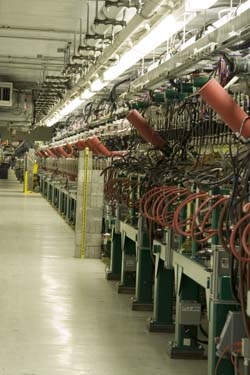Director's Corner
18 September 2008
 Barry Barish |
The Spallation Neutron Source at Oak Ridge Laboratory
A few weeks ago, while at Oak Ridge National Laboratory as a panelist at the National Science and Technology Summit, I had the opportunity to visit the recently completed Spallation Neutron Source (SNS). The US Department of Energy (DOE) Office of Science has funded the construction of this new 1.4-billion-dollar accelerator-based neutron source, which provides the world’s most intense pulsed neutron beams for scientific research and industrial development. This project promises to move neutron science into a new era and both the execution of the project and some key technologies are of important to our efforts towards the International Linear Collider.
 Aerial view of the Oak Ridge Spallation Neutron Source Aerial view of the Oak Ridge Spallation Neutron Source |
 The SNS complex showing the technical contributions from different DOE laboratories The SNS complex showing the technical contributions from different DOE laboratories |
This is the first major investment in a new neutron source dedicated to scientific research and industrial applications for some time. The demands for such a facility, especially for developing new materials by understanding and developing them on an atomic level, has become more and more important to our modern industrialised society. The SNS facility will produce such neutron beams for a wide array of experiments, by producing an intense beam of protons and directing it into a sophisticated mercury target where the neutrons are produced by a nuclear process called spallation. The produced neutrons are distributed into up to 50 beams for user experiments.
This project is an example for us in several ways. First and most obvious, it represents a large investment by DOE in a research facility, so the success of this project, as well as their lessons learned are important for us to study. One very interesting aspect of this project is that it involved significant contributions and collaboration between multiple DOE laboratories (see graphic). Although this clearly complicates the management, it makes it possible to tap the different skills and strengths of the different laboratories brought together to construct the project. For the ILC, the US part of our effort also involves several DOE laboratories, as well as, of course, collaboration with laboratories around the world.
The overall scheme for SNS involves creating negatively charged ions, injecting them into a linear accelerator, which accelerates them to very high energies. They are then sent though a foil that strips off their electrons, producing protons. The protons are accumulated into bunches in a ring and directed to the mercury target, where the neutron beams are created. This is the technically most relevant overlap between ILC and SNS: the linac of the SNS complex that accelerates the beam from 2.5 MeV to 1 GeV. The linac uses normal conducting and superconducting radio frequency cavities, plus some focusing and steering magnets. The third (highest energy) part of the linac accelerates from 200 MeV to 1GeV and employs niobium superconducting cavities operating at 2 K.
The SNS has already operated at about half of its designed 1.4 megawatts of beam power. Much of the extensive experimental programme is in place and full operations are beginning. I am confident that we can all look forward to a very productive research programme from this impressive facility. It is worth noting that the scale of the SNS is approaching what might be required for a US contribution to the ILC, depending on where it is located. Large-scale science facilities like the SNS are at about the limit of what can be done nationally or regionally. To go to the next scale, represented by the ILC, will require a global collaboration like the one we are pursuing.
-- Barry Barish
